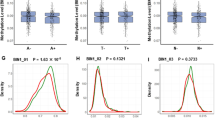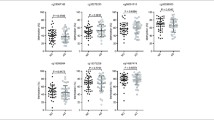Abstract
Previous studies report detection of high concentrations of circulating nucleic acids (CNAs), which are likely related to cell apoptosis, in the plasma of patients with cancers, stroke, trauma, and relapsing-remitting multiple sclerosis. However, the relationship between Alzheimer’s disease (AD) and CNAs is unclear. A total of 36 adult participants (9 non-demented controls and 27 patients with AD) and patients with mild AD, who met the criteria for probable AD, were enrolled in the present study, which was conducted at the Department of Neurology of National Cheng Kung University Hospital. The CNA levels were increased in the plasma of patients with AD, culture medium of amyloid-β-treated SH-SY5Y cells, and plasma from a mouse model of AD. The CNA concentrations in the plasma were positively correlated with the cognitive scores. Further, CNAs in patients with AD contained neuronal tissue-specific methylated LHX2, at CpG sites 1 and 5. These results showed that the increased levels of plasma CNAs could be related to neuronal cell death that was induced by β-amyloid toxicity. Thus, the results suggested that the levels of plasma CNAs and LHX2 methylation might serve as potential biomarkers for the diagnosis of AD, particularly during the early stages of the disease.




Similar content being viewed by others
References
Lu PH, Edland SD, Teng E, Tingus K, Petersen RC, Cummings JL, Alzheimer’s Disease Cooperative Study Group (2009) Donepezil delays progression to AD in MCI subjects with depressive symptoms. Neurology 72(24):2115–2121. https://doi.org/10.1212/WNL.0b013e3181aa52d3
Galimberti D, Scarpini E (2011) Disease-modifying treatments for Alzheimer’s disease. Ther Adv Neurol Disord 4(4):203–216. https://doi.org/10.1177/1756285611404470
Traver S, Assou S, Scalici E, Haouzi D, Al-Edani T, Belloc S, Hamamah S (2014) Cell-free nucleic acids as non-invasive biomarkers of gynecological cancers, ovarian, endometrial and obstetric disorders and fetal aneuploidy. Hum Reprod Update 20(6):905–923. https://doi.org/10.1093/humupd/dmu031
Schwarzenbach H (2013) Circulating nucleic acids as biomarkers in breast cancer. Breast Cancer Res : BCR 15(5):211. https://doi.org/10.1186/bcr3446
Chang CP, Chia RH, Wu TL, Tsao KC, Sun CF, Wu JT (2003) Elevated cell-free serum DNA detected in patients with myocardial infarction. Clinica Chimica Acta; Int J Clinical Chemistry 327(1–2):95–101
Rainer TH, Wong LK, Lam W, Yuen E, Lam NY, Metreweli C, Lo YM (2003) Prognostic use of circulating plasma nucleic acid concentrations in patients with acute stroke. Clin Chem 49(4):562–569
Lo YM, Rainer TH, Chan LY, Hjelm NM, Cocks RA (2000) Plasma DNA as a prognostic marker in trauma patients. Clin Chem 46(3):319–323
Fox A, Gal S, Fisher N, Smythe J, Wainscoat J, Tyler MP, Watt SM, Harris AL (2008) Quantification of circulating cell-free plasma DNA and endothelial gene RNA in patients with burns and relation to acute thermal injury. Burns : J Int Soc Burn Injuries 34(6):809–816. https://doi.org/10.1016/j.burns.2007.10.003
Liggett T, Melnikov A, Tilwalli S, Yi Q, Chen H, Replogle C, Feng X, Reder A et al (2010) Methylation patterns of cell-free plasma DNA in relapsing-remitting multiple sclerosis. J Neurol Sci 290(1–2):16–21. https://doi.org/10.1016/j.jns.2009.12.018
Sandberg R, Yasuda R, Pankratz DG, Carter TA, Del Rio JA, Wodicka L, Mayford M, Lockhart DJ et al (2000) Regional and strain-specific gene expression mapping in the adult mouse brain. Proc Natl Acad Sci U S A 97(20):11038–11043
Letwin NE, Kafkafi N, Benjamini Y, Mayo C, Frank BC, Luu T, Lee NH, Elmer GI (2006) Combined application of behavior genetics and microarray analysis to identify regional expression themes and gene-behavior associations. J Neurosci 26(20):5277–5287. https://doi.org/10.1523/JNEUROSCI.4602-05.2006
Lein ES, Hawrylycz MJ, Ao N, Ayres M, Bensinger A, Bernard A, Boe AF, Boguski MS et al (2007) Genome-wide atlas of gene expression in the adult mouse brain. Nature 445(7124):168–176. https://doi.org/10.1038/nature05453
Roth RB, Hevezi P, Lee J, Willhite D, Lechner SM, Foster AC, Zlotnik A (2006) Gene expression analyses reveal molecular relationships among 20 regions of the human CNS. Neurogenetics 7(2):67–80. https://doi.org/10.1007/s10048-006-0032-6
Ladd-Acosta C, Pevsner J, Sabunciyan S, Yolken RH, Webster MJ, Dinkins T, Callinan PA, Fan JB et al (2007) DNA methylation signatures within the human brain. Am J Hum Genet 81(6):1304–1315. https://doi.org/10.1086/524110
Ghosh S, Yates AJ, Fruhwald MC, Miecznikowski JC, Plass C, Smiraglia D (2010) Tissue specific DNA methylation of CpG islands in normal human adult somatic tissues distinguishes neural from non-neural tissues. Epigenetics 5(6):527–538
Lichtenstein AV, Melkonyan HS, Tomei LD, Umansky SR (2001) Circulating nucleic acids and apoptosis. Ann N Y Acad Sci 945:239–249
Stroun M, Lyautey J, Lederrey C, Olson-Sand A, Anker P (2001) About the possible origin and mechanism of circulating DNA apoptosis and active DNA release. Clin Chim Acta 313(1–2):139–142
Tsai KJ, Tsai YC, Shen CK (2007) G-CSF rescues the memory impairment of animal models of Alzheimer’s disease. J Exp Med 204(6):1273–1280. https://doi.org/10.1084/jem.20062481
Mullan M, Crawford F, Axelman K, Houlden H, Lilius L, Winblad B, Lannfelt L (1992) A pathogenic mutation for probable Alzheimer’s disease in the APP gene at the N-terminus of beta-amyloid. Nat Genet 1(5):345–347. https://doi.org/10.1038/ng0892-345
McKhann G, Drachman D, Folstein M, Katzman R, Price D, Stadlan EM (1984) Clinical diagnosis of Alzheimer’s disease: report of the NINCDS-ADRDA Work Group under the auspices of Department of Health and Human Services Task Force on Alzheimer’s disease. Neurology 34(7):939–944
Morris JC (1993) The clinical dementia rating (CDR): current version and scoring rules. Neurology 43(11):2412–2414
Lo YM, Tein MS, Lau TK, Haines CJ, Leung TN, Poon PM, Wainscoat JS, Johnson PJ et al (1998) Quantitative analysis of fetal DNA in maternal plasma and serum: implications for noninvasive prenatal diagnosis. Am J Hum Genet 62(4):768–775. https://doi.org/10.1086/301800
Folstein MF, Folstein SE, McHugh PR (1975) “Mini-mental state”. A practical method for grading the cognitive state of patients for the clinician. J Psychiatr Res 12(3):189–198
Teng EL, Hasegawa K, Homma A, Imai Y, Larson E, Graves A, Sugimoto K, Yamaguchi T et al (1994) The Cognitive Abilities Screening Instrument (CASI): a practical test for cross-cultural epidemiological studies of dementia. Int Psychogeriatrics / IPA 6(1):45–58 discussion 62
Tsai RC, Lin KN, Wu KY, Liu HC (2004) Improving the screening power of the cognitive abilities screening instrument, Chinese version. Dement Geriatr Cogn Disord 18(3–4):314–320. https://doi.org/10.1159/000080125
Vaissiere T, Cuenin C, Paliwal A, Vineis P, Hoek G, Krzyzanowski M, Airoldi L, Dunning A et al (2009) Quantitative analysis of DNA methylation after whole bisulfitome amplification of a minute amount of DNA from body fluids. Epigenetics 4(4):221–230
Butt AN, Swaminathan R (2008) Overview of circulating nucleic acids in plasma/serum. Ann N Y Acad Sci 1137:236–242. https://doi.org/10.1196/annals.1448.002
Urbanova M, Plzak J, Strnad H, Betka J (2010) Circulating nucleic acids as a new diagnostic tool. Cell Mol Biol Lett 15(2):242–259. https://doi.org/10.2478/s11658-010-0004-6
Zhu S, Stavrovskaya IG, Drozda M, Kim BY, Ona V, Li M, Sarang S, Liu AS et al (2002) Minocycline inhibits cytochrome c release and delays progression of amyotrophic lateral sclerosis in mice. Nature 417(6884):74–78. https://doi.org/10.1038/417074a
Qin ZX, Zhu HY, Hu YH (2009) Effects of lysophosphatidylcholine on beta-amyloid-induced neuronal apoptosis. Acta Pharmacol Sin 30(4):388–395. https://doi.org/10.1038/aps.2009.25
Choi JJ, Reich CF 3rd, Pisetsky DS (2004) Release of DNA from dead and dying lymphocyte and monocyte cell lines in vitro. Scand J Immunol 60(1–2):159–166. https://doi.org/10.1111/j.0300-9475.2004.01470.x
Lesne S, Koh MT, Kotilinek L, Kayed R, Glabe CG, Yang A, Gallagher M, Ashe KH (2006) A specific amyloid-beta protein assembly in the brain impairs memory. Nature 440(7082):352–357. https://doi.org/10.1038/nature04533
Resende R, Ferreiro E, Pereira C, Resende de Oliveira C (2008) Neurotoxic effect of oligomeric and fibrillar species of amyloid-beta peptide 1-42: involvement of endoplasmic reticulum calcium release in oligomer-induced cell death. Neuroscience 155(3):725–737. https://doi.org/10.1016/j.neuroscience.2008.06.036
Reese LC, Zhang W, Dineley KT, Kayed R, Taglialatela G (2008) Selective induction of calcineurin activity and signaling by oligomeric amyloid beta. Aging Cell 7(6):824–835. https://doi.org/10.1111/j.1474-9726.2008.00434.x
Botezatu I, Serdyuk O, Potapova G, Shelepov V, Alechina R, Molyaka Y, Ananev V, Bazin I et al (2000) Genetic analysis of DNA excreted in urine: a new approach for detecting specific genomic DNA sequences from cells dying in an organism. Clin Chem 46(8 Pt 1):1078–1084
Garcia-Romero N, Carrion-Navarro J, Esteban-Rubio S, Lazaro-Ibanez E, Peris-Celda M, Alonso MM, Guzman-De-Villoria J, Fernandez-Carballal C et al (2017) DNA sequences within glioma-derived extracellular vesicles can cross the intact blood-brain barrier and be detected in peripheral blood of patients. Oncotarget 8(1):1416–1428. https://doi.org/10.18632/oncotarget.13635
Giacona MB, Ruben GC, Iczkowski KA, Roos TB, Porter DM, Sorenson GD (1998) Cell-free DNA in human blood plasma: length measurements in patients with pancreatic cancer and healthy controls. Pancreas 17(1):89–97
Jahr S, Hentze H, Englisch S, Hardt D, Fackelmayer FO, Hesch RD, Knippers R (2001) DNA fragments in the blood plasma of cancer patients: quantitations and evidence for their origin from apoptotic and necrotic cells. Cancer Res 61(4):1659–1665
Suzuki N, Kamataki A, Yamaki J, Homma Y (2008) Characterization of circulating DNA in healthy human plasma. Clinica Chimica Acta; Int J Clinical Chemistry 387(1–2):55–58. https://doi.org/10.1016/j.cca.2007.09.001
Rykova EY, Tsvetovskaya GA, Sergeeva GI, Vlassov VV, Laktionov PP (2008) Methylation-based analysis of circulating DNA for breast tumor screening. Ann N Y Acad Sci 1137:232–235. https://doi.org/10.1196/annals.1448.021
Li M, Chen WD, Papadopoulos N, Goodman SN, Bjerregaard NC, Laurberg S, Levin B, Juhl H et al (2009) Sensitive digital quantification of DNA methylation in clinical samples. Nat Biotechnol 27(9):858–863. https://doi.org/10.1038/nbt.1559
Schilling E, Rehli M (2007) Global, comparative analysis of tissue-specific promoter CpG methylation. Genomics 90(3):314–323. https://doi.org/10.1016/j.ygeno.2007.04.011
Illingworth R, Kerr A, Desousa D, Jorgensen H, Ellis P, Stalker J, Jackson D, Clee C et al (2008) A novel CpG island set identifies tissue-specific methylation at developmental gene loci. PLoS Biol 6(1):e22. https://doi.org/10.1371/journal.pbio.0060022
Acknowledgements
The authors thank M.-T. Yu, C.-H. Pan, and Y.-T. Sun for their technical assistance in the study.
Abbreviations and Acronyms
CNAs, circulating nucleic acids; AD Alzheimer’s disease; LHX2, LIM homeobox 2 gene aCSF, artificial cerebrospinal fluid; CDR, Clinical Dementia Rating; MMSE, Mini-Mental State Examination; CASI, Cognitive Abilities Screening Instrument; MS, multiple sclerosis
Funding
This study was supported by grants from the NCKU Hospital Medical Center (NCKUH-10006002); Ministry of Health, Taiwan (DOH101-TD-B-111-0002); and Ministry of Science and Technology, Taiwan (MOST-104-2745-B-006-001, MOST-105-2628-B-006-016-MY3, and MOST-106-2628-B-006-001-MY4).
Author information
Authors and Affiliations
Contributions
K.-J. Tsai, Y.-M. Kuo, and M.-C. Pai contributed substantially to the conception and design of the research project and its scientific interpretation; K.-J. Tsai wrote the manuscript; I.-F. Wang and P.-M. Chiang took responsibility for the statistical analysis and reporting of the results.
Corresponding author
Ethics declarations
Conflict of Interests
The authors declare that they have no competing interests.
Electronic supplementary material
ESM1
(PDF 324 kb)
Rights and permissions
About this article
Cite this article
Pai, MC., Kuo, YM., Wang, IF. et al. The Role of Methylated Circulating Nucleic Acids as a Potential Biomarker in Alzheimer’s Disease. Mol Neurobiol 56, 2440–2449 (2019). https://doi.org/10.1007/s12035-018-1229-z
Received:
Accepted:
Published:
Issue Date:
DOI: https://doi.org/10.1007/s12035-018-1229-z




